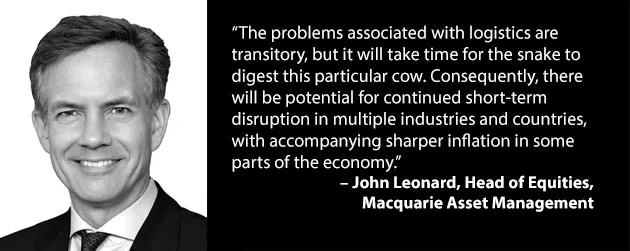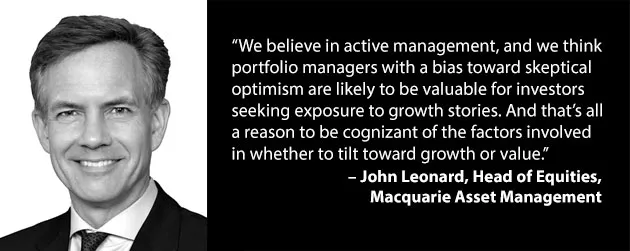At the end of the first year of the pandemic, some analysts weren’t predicting a particularly strong showing for equities in 2021, because they had delivered such strong returns from March to December 2020. Nonetheless, corporate earnings blew through estimates, and equities markets in the U.S. had a fairly impressive year. As of November 30, 2021, the S&P 500 Index had returned 23.2% year to date, and 45.8% since the end of December 2019, or 21.7% on an annualized basis.
However, the strong showing of the U.S. equity markets was not matched elsewhere. Other developed markets delivered weaker though still positive performance, while the year-to-date return as of November 30, 2021 for emerging markets was negative.

For investors, the next logical questions are whether the U.S. equity markets can continue to expand through 2022, and whether other equity markets around the world will be able to show strong performance.
“In our view, the answers to both of those questions are positive,” says John Leonard, Head of Equities at Macquarie Asset Management.
Of course, market expansions cannot continue forever. While some market sectors arguably still have room for further rises, there are other parts of the U.S. equity market that are starting to look slightly stretched from a valuation perspective. In addition, earnings are unlikely to see the same kind of growth as in 2021.
“While remaining basically optimistic, investors should be mindful of potential hurdles in 2022, and watch for signs of strength or weakness as the year progresses,” says Leonard. “Concerns range from inflation – thought to be transitory, but still showing some staying power at the time – to slowing growth in key markets such as China. The pandemic has had an impact on these issues, but it would be simplistic to say that these problems will all disappear as vaccination rates increase.”
Hear directly from John Leonard and other experts about their views on investment opportunities.
Inflation and supply chains: Tied to the pandemic or tied up in knots?
Inflation continues to be a nagging source of concern to equity investors. According to the U.S. Bureau of Labor Statistics, the 12-month change in the U.S. Consumer Price Index (CPI) has consistently been above 4% since April 2021, after generally being under 2% since the start of 2019, and reached a level of 6.2% in October 2021. (However, the 12-month change in the “core” CPI, which excludes food and energy, has been somewhat lower over the same periods, and many observers consider this offering a less volatile indication of price trends across the U.S. economy.)It has been suggested that the recent high inflation numbers are mainly caused by global supply chains and issues related to the pandemic, but other observers contend that more fundamental drivers are to blame. If the principal cause of current inflation is indeed supply chain problems, then it seems reasonable to expect that the situation will normalize, as suppliers, consumers, and logistics firms adjust.
All supply chains consist of two parts: inventory, with products located in places as diverse as the U.S. Midwest or Thailand, and logistics, which involves moving those products from source to destination. Recent supply chain snarls are mainly connected to logistics. As economies emerged from lockdown and consumers began buying again, manufacturers have seen renewed demand for their products, but logistics firms have struggled to meet those demands due to a backlog at chokepoints such as major ports. In this sense, the inflation being experienced now has been partly caused by the engineered slowdown of the global economy.
“The problems associated with logistics are transitory, but it will take time for the snake to digest this particular cow,” says Leonard. “Consequently, there will be potential for continued short-term disruption in multiple industries and countries, with accompanying sharper inflation in some parts of the economy.”
Some observers have suggested that these problems could lead to a prolonged surge in inflation, if employers believe that they need to offer much higher wages to attract workers. This is certainly a possibility, but it does not appear that this is happening yet. Overall, it is unlikely that an entrenched inflationary effect is developing, partly because so many parts of the overall economic system remain intact.
Labor: Looking beyond short-term upheaval
Still, there are many open questions related to possible long-term effects of pandemic-prompted issues. For example, parts of the labor market are said to be experiencing very tight supply. Part of this may be baby boomers retiring earlier than expected, perhaps because higher equity performance and housing values have increased wealth – or from the effects of the pandemic on the service industry, and its reported difficulties in rehiring workers after the shutdown. Nevertheless, the available data suggest that average inflation-adjusted hourly wages for production and non-supervisory workers in the non-governmental sector in the U.S. rose at an annualized rate of 1.5% between December 2019 and October 2021, which does not suggest any broad-based tightening of labor supply.1It remains to be seen how soon the current environment will resolve, but long-term effects may resolve other issues too. One factor affecting the supply chain, for instance, is a shortage of truck drivers to deliver goods. However, data from the U.S. Department of Labor suggest that average inflation-adjusted hourly wages for production and non-supervisory workers in the transportation sector rose at an annualized rate of 1.3% between December 2019 and October 2021, which was slightly lower than the rate for the broad labor market.2
“You could argue that a decade from now, very few truck drivers may be needed if there is a rapid expansion in the use of autonomous vehicles,” says Leonard. “But before that can happen, there will need to be broad agreement about who will be liable in the event of accidents involving such vehicles and pedestrians, static structures, or other road users, as well as detailed analysis by the insurance industry of appropriate premiums to be paid by firms employing such vehicles. While we’re a long way off from that scenario, these are the kinds of longer-term aspects which may have an important effect on the business prospects for sectors and individual companies.”

Growth vs value: A shift?
Another potential fallout from COVID-19 could be a change in the relative attractiveness of growth and value stocks. Since the global financial crisis of 2008, markets have been favoring companies with stronger growth prospects, for a couple of reasons. The first is the “duration effect” driver, where companies with low current profits but the potential for much better results well into the future may look relatively more attractive than shorter duration companies, because of low and declining interest rates. However, interest rates in many countries are already very low, and if rates go up, you may see a shift in the growth vs. value paradigm.The second reason growth companies have done well is that a handful of mega-cap U.S. firms have excelled at converting earnings into cash flow, creating a perception that growth companies in general can generate large amounts of free cash flow for their shareholders. However, notes Leonard, “We are not convinced that every company with high consensus estimates for future growth will be able to deliver on those expectations.”
In the view of Macquarie, the current environment bears some resemblance to the late 1990s, when anything connected to technology, media, or telecoms seemed to rise more or less in lockstep. While not precisely the same situation now, there is similar emphasis on investments that some investors think can provide stable, ongoing growth indefinitely.
“Many investors who have put money into such companies may not have thought fully about the risks, or what may happen if these companies stumble. We believe in active management, and we think portfolio managers with a bias toward skeptical optimism are likely to be valuable for investors seeking exposure to growth stories. And that’s all a reason to be cognizant of the factors involved in whether to tilt toward growth or value,” says Leonard.
China holds the key
The two countries that get the most attention globally these days are the U.S. and China. The outlook for relations between these two countries, and for their connections to their allies and trading partners, will be central for any investor’s portfolio. China is an emerging market, but it is so much larger than any of the other emerging markets that it requires consideration separately.The Chinese government has recently launched a series of new regulations and rules, aimed primarily at technology companies but affecting everything from online gaming to after-school tutoring. It could be argued that the government’s ability and willingness to institute such measures may eventually stamp down investor enthusiasm for some Chinese companies. However, China is so big and systematically important, that most investors will still continue to look for companies and initiatives which are likely to be allowed to grow without too much government interference. Despite this, demographics and the underlying growth could raise a caution flag.
“There is little doubt that savvy investors will be starting to take a slightly more skeptical attitude towards China than a few years ago,” says Leonard. “Active management may be able to steer investors away from blindly investing in the biggest Chinese firms, particularly as those seem precisely the entities most likely to attract unfavorable scrutiny from the Chinese government.”

Equities: An attractive choice
Current conditions may represent a classic case for equities. Rates on fixed income instruments are relatively unappealing in comparison, with spreads on most investment grade corporates running fairly low in historical terms. In other areas, investors are running into issues such as venture capital awash with money and insufficient opportunities, or commodities presenting high volatility without the returns to compensate.“Despite all the challenges facing the political and economic systems globally, we continue to believe that there are few, if any, assets that look as compelling as equities right now,” says Leonard. “Of course, we recognize that a well-balanced portfolio may well contain asset classes other than equities, but we think in current conditions, equities offer a decent combination of transparency, liquidity, and growth potential.”
In short, in the current market environment, at least for those who aren’t willing to lock up all their money longer term – or even if it’s because everything else tends to look worse right now – it’s easy to make a case for equities playing a substantial role in portfolios during 2022, and further into the future as well.
Download a comprehensive outlook, including fixed income and real assets.
1 Seasonally adjusted average hourly wages for all private; inflation adjustment, with seasonally adjusted US Consumer Price Index, all urban, all items; data from US Bureau of Labor Statistics website.
2 Seasonally adjusted average hourly wages for “trade, transportation, and utilities,” which is the narrowest relevant category; inflation adjustment with seasonally adjusted US Consumer Price Index, all urban, all items; data from US Bureau of Labor Statistics website.
More from Macquarie Asset Management:
Navigating a Tale of Two Tapers in Fixed IncomeWhy Tailwinds Will Continue in Real Assets
The Path to Investment Opportunity






